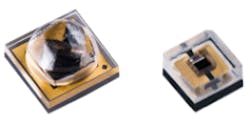Luminus Devices enters UV-C LED market, targets sterilization applications
Compact ultraviolet LEDs will enable novel approaches to sterilization and disinfection applications, and the potential of that market has led Luminus Devices to add shorter-wavelength UV-C devices to its portfolio.
Luminus Devices has announced the XBT-1313-UV and XST-3535-UV ultraviolet (UV) packaged LEDs targeting the disinfection and sterilization market segments. The new LEDs emit at 280 nm — within the UV-C band where emitted energy can instantly kill pathogens. Applications could range from water sterilization to usage in medical facilities to kill pathogens.
Interested in articles & announcements on UV LEDs in life science applications?
We’ve been charting the progress of UV-C LEDs for several years. The UV-C LED technology — in terms of cost, radiometric power output, efficiency, reliability, and lifetime — has trailed the longer-wavelength UV-B and UV-A LEDs that are primarily used in industrial applications such as curing. We covered the basics of the UV bands in an article about presentations at Strategies in Light a few years back.
Still, we have seen steady improvement in performance in the past few years. For example, Crystal IS announced products earlier this year that it said offer the power output/cost ratio that would lead to high-volume commercialization. Those products deliver in the range of 30–40 mW of radiometric power.
We will have a session at our upcoming Lighting for Health and Wellbeing Conference that will cover UV and near-UV light for both instantaneous-disinfection or purification and continuous-disinfection applications. Join us to learn more July 18 in Newport Beach, CA.
The Luminus UV LEDs that were just announced span a broad gap in terms of emitter size and power output. As the model numbers imply, the smaller device measures 1.3×1.3 mm in footprint while the larger measures 3.5×3.5 mm. The smaller LED delivers 11 mW of peak output driven at 100 mA and the larger LED delivers peak output of 60 mW at 350 mA.
Those performance levels could certainly enable many developments in disinfection, although other factors such as cost and reliability are factors as well. Moreover, the two different emitter sizes offered by Luminus could serve in vastly different form factors. Both LEDs are based on surface-mount technology (SMT) and the smaller device stands just 0.85 mm tall.
Luminus clearly sees the market as ready to expand. “Air, surface, and water disinfection markets will see a significant number of new products and new product categories over the next 36 months,” said Stephane Bellosguardo, vice president of specialty lighting marketing at Luminus. “Just as the computer industry was driven by ever smaller and faster processors, so will be the innovation in markets like air and water purification with miniature products like our 1313 UV-C LED.”
The new UV-C LEDs join an existing portfolio of UV-A LEDs from Luminus offered both in SMT packages and in small modules based on metal-core printed-circuit boards (MCPCBs). The company has previously targeted curing, 3D printing, endoscopy, horticultural, and other applications for UV.
Also, we would add a note about UV-C applications relative to LED lifetime and cost. Generally, there has been concern in the industry that UV-C LED lifetimes need improvement to deliver on the promise of the solid-state lighting (SSL) approach to the sterilization sector. But we just published a feature article that does a great job of explaining that LED-based products will inherently deliver a different usage model and scenario relative to products based on legacy UV sources. In fact, UV-C LEDs may well already outlast legacy sources in many applications, and even at a higher upfront cost deliver superior return on investment.

Maury Wright | Editor in Chief
Maury Wright is an electronics engineer turned technology journalist, who has focused specifically on the LED & Lighting industry for the past decade. Wright first wrote for LEDs Magazine as a contractor in 2010, and took over as Editor-in-Chief in 2012. He has broad experience in technology areas ranging from microprocessors to digital media to wireless networks that he gained over 30 years in the trade press. Wright has experience running global editorial operations, such as during his tenure as worldwide editorial director of EDN Magazine, and has been instrumental in launching publication websites going back to the earliest days of the Internet. Wright has won numerous industry awards, including multiple ASBPE national awards for B2B journalism excellence, and has received finalist recognition for LEDs Magazine in the FOLIO Eddie Awards. He received a BS in electrical engineering from Auburn University.






